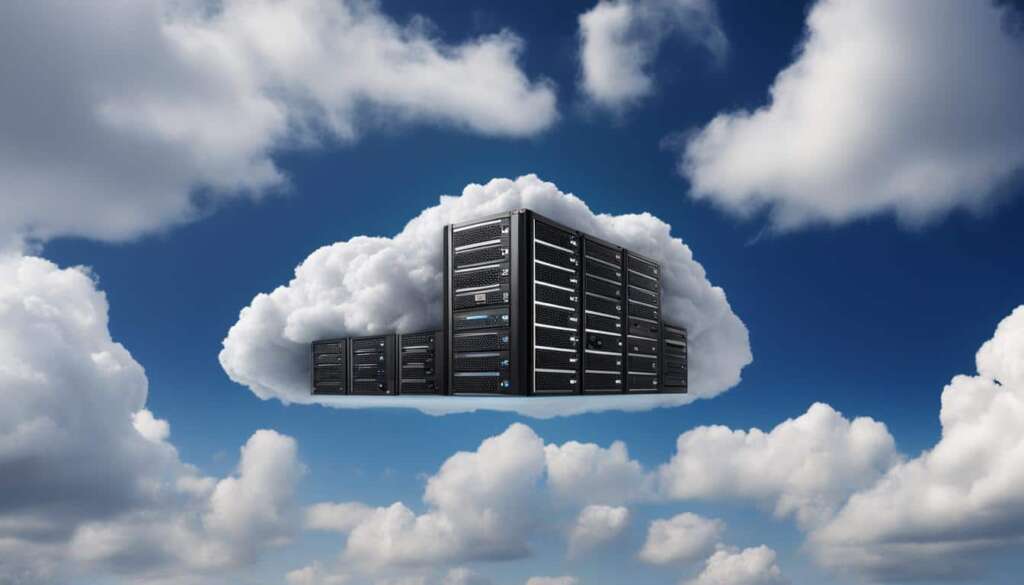Table of Contents
Welcome to our comprehensive guide on cloud computing. In this article, we will provide you with a clear and concise overview of what cloud computing is and how it works. Whether you are new to the concept or looking to deepen your understanding, this article will equip you with the knowledge you need to navigate the world of cloud computing.
So, what exactly is cloud computing? In simple terms, cloud computing refers to the delivery of computing services over the internet. Instead of relying on local infrastructure and hardware, businesses can access a wide range of resources, including servers, storage, databases, networking, software, analytics, and intelligence, on-demand through the cloud. This allows for greater flexibility, scalability, and cost-efficiency.
Cloud computing can be categorized into three main types: infrastructure as a service (IaaS), platform as a service (PaaS), and software as a service (SaaS). These categories represent different levels of accessibility and control that users have over their computing resources. Whether you need a virtual server instance, a development environment for software, or access to a specific application, cloud computing offers a range of solutions to suit your needs.
One of the key benefits of cloud computing is its ability to enable organizations to scale their computing resources according to their needs. With cloud computing, you only pay for what you use, allowing for efficient cost management. Additionally, cloud computing allows for remote access to data and applications from anywhere with an internet connection, enhancing productivity and flexibility for businesses.
As cloud computing continues to evolve and gain momentum, it is crucial to stay informed about the latest trends and developments in the industry. In the next sections, we will delve deeper into how cloud computing works, the different types of cloud computing services, deployment models, and the growing importance of cloud spending.
Stay tuned for the upcoming sections, where we will explore these topics in more detail.
How Does Cloud Computing Work?
Cloud computing works by connecting client devices to remote physical servers, databases, and computers over the internet. The front-end, which includes the client device and web browser, communicates with the back-end, which consists of the servers and databases. A central server manages the communication between the front-end and back-end. Virtualization and automation technologies play a significant role in cloud computing, allowing for the easy provisioning and abstraction of resources and workloads. This enables users to request and utilize resources without direct intervention from the cloud provider’s IT staff.
Cloud computing revolutionizes the way organizations handle their computing needs. It eliminates the requirement for local infrastructure and hardware, enabling businesses to access computing resources on-demand. By leveraging remote servers and databases, organizations can reduce the cost and complexity of managing and maintaining in-house systems.
Virtualization, a key aspect of cloud computing, enables the creation of virtual environments that abstract the underlying physical resources. This allows multiple users to share the same physical infrastructure while maintaining isolation and security. Virtualization also facilitates the efficient utilization of resources, as it enables the allocation of computing power based on the current needs and demands.
Automation is another crucial component of cloud computing. Automation technologies streamline various processes and tasks, reducing the need for manual intervention. Through automation, organizations can deploy and scale applications, manage and monitor resources, and optimize workloads effectively. Additionally, automation helps ensure consistency, reliability, and scalability in cloud environments.
Different Types of Cloud Computing Services
Cloud computing services play a crucial role in enabling businesses to leverage the power of the cloud for their computing needs. These services can be broadly categorized into three main types: Infrastructure as a Service (IaaS), Platform as a Service (PaaS), and Software as a Service (SaaS).
1. Infrastructure as a Service (IaaS):
IaaS providers offer organizations the fundamental building blocks of cloud infrastructure. This includes virtual server instances, storage, and APIs for migrating workloads to the cloud. With IaaS, businesses have the flexibility to scale their infrastructure up or down as needed, without worrying about managing physical hardware.
2. Platform as a Service (PaaS):
PaaS providers offer a complete development platform and environment in the cloud. This includes tools, frameworks, and runtime environments for building, testing, and deploying web and mobile applications. PaaS eliminates the need for developers to worry about infrastructure management, allowing them to focus solely on creating and delivering innovative software solutions.
3. Software as a Service (SaaS):
SaaS delivers ready-to-use software applications over the internet, accessible from any device with an internet connection and a web browser. This eliminates the need for users to install and maintain software locally on their devices. Popular examples of SaaS include customer relationship management (CRM) systems, enterprise resource planning (ERP) software, and collaboration tools.
Each type of cloud computing service offers unique benefits and caters to different user needs. The table below provides a comparison of the key features and characteristics of IaaS, PaaS, and SaaS:
| IaaS | PaaS | SaaS |
|---|---|---|
| Provides infrastructure components | Offers a complete development platform | Delivers ready-to-use software applications |
| Offers scalability and flexibility | Simplifies application development and deployment | Allows easy access to software applications from any device |
| Requires more user control and management | Reduces the need for infrastructure management | Requires minimal user maintenance and updates |

By understanding the different types of cloud computing services available, businesses can make informed decisions on which service best suits their requirements. Whether it’s the flexibility and control of IaaS, the development ease of PaaS, or the convenience of SaaS, cloud computing services offer organizations the ability to leverage the power of the cloud to drive innovation and achieve their business goals.
Cloud Computing Deployment Models
Cloud computing deployment models play a crucial role in determining how organizations access and utilize cloud services. There are three main types of cloud deployment models: private cloud, public cloud, and hybrid cloud. Each model offers unique advantages and considerations.
Private Cloud
A private cloud is a cloud environment exclusively dedicated to a single organization. It is typically hosted within the organization’s own data center, allowing for strict control over security, compliance, and customization. Private cloud services are delivered exclusively to internal users, providing a high level of privacy and data control.
Public Cloud
On the other hand, the public cloud refers to cloud services provided by third-party cloud service providers. These providers deliver a wide range of services over the internet, serving multiple organizations and users. Public cloud services are cost-effective, scalable, and readily available, making them ideal for businesses that require agility and rapid deployment. However, they may have limited customization options and involve shared resources with other users.
Hybrid Cloud
Hybrid cloud combines elements of both private and public clouds, allowing organizations to leverage the benefits of both models. It enables workload flexibility and optimization by allowing certain data and applications to be hosted on a private cloud, while others are deployed on a public cloud. This model offers greater flexibility, control, and cost-efficiency, making it suitable for organizations with varying data and workload requirements.
Organizations can also adopt a multi-cloud approach, which involves using multiple infrastructure as a service (IaaS) providers. This strategy allows organizations to minimize the risks associated with relying on a single cloud provider and take advantage of competitive pricing or specific services offered by different providers.
Conclusion
Cloud computing offers a multitude of benefits that can greatly enhance business operations. One of the key advantages is cost management, as organizations can avoid the upfront investment in hardware and infrastructure and instead pay for the resources they use. This pay-per-use pricing model allows for greater flexibility and cost efficiency.
Scalability is another significant benefit of cloud computing. Businesses can easily scale up or down their computing resources based on demand, ensuring optimal performance without the need for manual intervention or hardware upgrades. This flexibility enables organizations to adapt quickly to changing business needs and market conditions.
Data and workload mobility are facilitated by cloud computing, allowing users to access their applications and data from anywhere with an internet connection. This remote accessibility enhances productivity and enables collaborative work. Additionally, cloud computing providers typically offer robust security measures to protect sensitive data and minimize the risk of data loss or breaches.
Cloud spending continues to rise as more organizations recognize the value and advantages of cloud computing. With predictions pointing to significant growth in the coming years, businesses are investing in cloud services to improve operational efficiency and gain a competitive edge. The adoption of cloud computing has been further accelerated by the COVID-19 pandemic, which highlighted the importance of remote access to computing resources for business continuity and remote work capabilities.
FAQ
What is cloud computing?
Cloud computing is the delivery of computing services, including servers, storage, databases, networking, software, analytics, and intelligence, over the internet. It allows businesses to access these resources on-demand, without the need for local infrastructure and hardware.
How does cloud computing work?
Cloud computing works by connecting client devices to remote physical servers, databases, and computers over the internet. The front-end, which includes the client device and web browser, communicates with the back-end, which consists of the servers and databases. A central server manages the communication between the front-end and back-end.
What are the different types of cloud computing services?
Cloud computing services can be categorized into three main types: infrastructure as a service (IaaS), platform as a service (PaaS), and software as a service (SaaS). Each type of service provides different levels of flexibility and control to users.
What are the cloud computing deployment models?
Cloud computing deployment models include private cloud, public cloud, and hybrid cloud. In a private cloud, services are delivered from a company’s own data center exclusively to internal users. A public cloud is a third-party cloud service provider that delivers services over the internet. Hybrid cloud combines public and private clouds, allowing for workload flexibility and optimization.
What are the benefits of cloud computing?
Cloud computing offers several benefits, including cost management, scalability, pay-per-use pricing, data and workload mobility, and improved productivity and performance. Organizations can choose from different cloud providers based on their specific needs and requirements.













